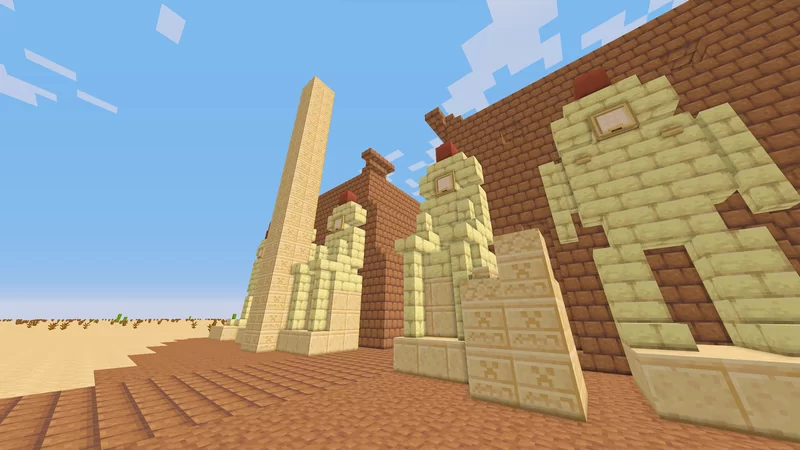Published Oct 7th, 2023, 10/7/23 8:00 pm
- 416 views, 2 today
- 23 downloads, 0 today
0
Map Note
Due to the fact that not everything can be accurately represented in Minecraft, there were some artistic liberties I had to take in the build. For this reason, certain aspects of the build may not be 100% accurately depicted to real life. With that being said, I think I put a certain level of effort into the build to make it accurate, despite those difficulties.
General Information
The Luxor Temple is a… temple that remains from the times of ancient Egypt, “Ipet Resyt” in ancient Egyptian language. Made with sandstone, it’s located in the modern day city of Luxor, which at the time was referred to as Thebes. The Luxor Temple was built in the time of the New Kingdom, but some believe that there was an older monument in the same place beforehand because of certain reused stones. Luxor Temple is on the UNESCO World Heritage Sites list.
Creation
As previously mentioned, the temple was made using sandstone, a fairly available material in the area. Amenhotep III is attributed to be the pharaoh at the time of the creation of Luxor Temple. The intention of creation of the temple was to worship Amun and two other Egyptian gods, which will be mentioned later. It’s important to note that the entire temple wasn’t built under the reign of one specific pharaoh, but rather contributed towards by many different pharaohs like Tutankhamun, Seti I, Ramesses II, and others.
The temple started off under Amenhotep III to be fairly small, and after many pharaohs and their contributions, Ramesses II added a fairly big contribution by erecting a pylon at the entrance of the temple, as well as an open courtyard. Inscriptions on the walls of the temple also depict scenes from the times of the respective pharaohs who contributed to the construction of the temple.
Religious Significance
As many Ancient Egyptian monuments were dedicated to specific deities of their time, the Luxor Temple was no different, being dedicated to the god, Amun, as well as his wife, Mut, and son, Khonsu. These three gods make up what is now called the Theban Triad. This triad were the primary recipients of worship in the Karnak Temple Complex, which is the collection of various temples, chapels, shrines, and others in the area of modern day Luxor.
Fun fact: There is a mosque in the area called Abu al-Haggag Mosque. This mosque has been integrated into the structure of the temple, which was already a site of religious worship for the ancient Egyptians. In 395 CE, the Copts (a Christian Egyptian group) took over and converted a part of Luxor Temple into a church. Later on in 640, it was then converted into a mosque. Because of this chain of events, Luxor Temple is the oldest building in the world that is somewhat still in use besides tourism and archaeology, being used for over 3400 years straight.
Political Significance
Luxor Temple was also very politically significant. The temple was located in the city of Thebes, which was primarily the capital city of ancient Egypt for the Middle and New Kingdom eras. It was often used for important state ceremonies. For example, in coronation ceremonies, Pharaohs would come to the temple and seek the blessing of the gods before ascending to the throne. Pharaohs would also take oaths of office in the temple.
The beauty and grandeur of the temple alone is, or at least was for the ancient Egyptians, a testament to the power of the Pharaohs. Over time, many pharaohs would make additions to the temple. This is why you will see on layouts of Luxor Temple, areas designated to those pharaohs who added to the temple, the court of Amenhotep III or Ramesses II for example.
The Monument’s Effect Then and Today
Luxor Temple innovated in ancient Egypt in many different ways. It showcased advanced architectural techniques like pylons, obelisks, hieroglyphic inscriptions, and even alignment with Karnak Temple nearby. Not only that, but as previously mentioned, the grandeur of the temple demonstrated the power of the Pharaohs. It served and still serves today as a symbol of Egyptian culture.
Recent Controversy
10 years ago at the time of writing this, on May 24th 2013, a 15-year-old Chinese student named Ding Jinhao posted a picture on Weibo, a Chinese blogging website. In the picture, one could see one of the engravings at Luxor Temple, only this one had Chinese letters scratched into it, which read “Ding Jinhao was here.” After only one day, the post had attained 11k comments and 83k reposts.
The very next day, Ding Jinhao’s personal information was released through the “Human flesh search engine,” a concept similar to “doxxing.” This information was also posted on Weibo, and later that same day, it was reported that Ding’s parents had publicly apologized for the incident on video and that Ding himself was in tears.
One more day later, on May 26th, Ding’s elementary school’s website was hacked and a pop-up was uploaded to the site which mimicked Ding’s vandalism in Luxor. On the same day, Ding’s engraving was removed from the temple, but the picture Ding uploaded can still be found online.
After the incident had died down, a spokesperson for the Ministry of Foreign Affairs of the People’s Republic of China, Hong Lei, called out to Chinese citizens traveling around the world, beseeching them to comply with the laws of whatever area they are visiting and to behave civilly.
Due to the fact that not everything can be accurately represented in Minecraft, there were some artistic liberties I had to take in the build. For this reason, certain aspects of the build may not be 100% accurately depicted to real life. With that being said, I think I put a certain level of effort into the build to make it accurate, despite those difficulties.
General Information
The Luxor Temple is a… temple that remains from the times of ancient Egypt, “Ipet Resyt” in ancient Egyptian language. Made with sandstone, it’s located in the modern day city of Luxor, which at the time was referred to as Thebes. The Luxor Temple was built in the time of the New Kingdom, but some believe that there was an older monument in the same place beforehand because of certain reused stones. Luxor Temple is on the UNESCO World Heritage Sites list.
Creation
As previously mentioned, the temple was made using sandstone, a fairly available material in the area. Amenhotep III is attributed to be the pharaoh at the time of the creation of Luxor Temple. The intention of creation of the temple was to worship Amun and two other Egyptian gods, which will be mentioned later. It’s important to note that the entire temple wasn’t built under the reign of one specific pharaoh, but rather contributed towards by many different pharaohs like Tutankhamun, Seti I, Ramesses II, and others.
The temple started off under Amenhotep III to be fairly small, and after many pharaohs and their contributions, Ramesses II added a fairly big contribution by erecting a pylon at the entrance of the temple, as well as an open courtyard. Inscriptions on the walls of the temple also depict scenes from the times of the respective pharaohs who contributed to the construction of the temple.
Religious Significance
As many Ancient Egyptian monuments were dedicated to specific deities of their time, the Luxor Temple was no different, being dedicated to the god, Amun, as well as his wife, Mut, and son, Khonsu. These three gods make up what is now called the Theban Triad. This triad were the primary recipients of worship in the Karnak Temple Complex, which is the collection of various temples, chapels, shrines, and others in the area of modern day Luxor.
Fun fact: There is a mosque in the area called Abu al-Haggag Mosque. This mosque has been integrated into the structure of the temple, which was already a site of religious worship for the ancient Egyptians. In 395 CE, the Copts (a Christian Egyptian group) took over and converted a part of Luxor Temple into a church. Later on in 640, it was then converted into a mosque. Because of this chain of events, Luxor Temple is the oldest building in the world that is somewhat still in use besides tourism and archaeology, being used for over 3400 years straight.
Political Significance
Luxor Temple was also very politically significant. The temple was located in the city of Thebes, which was primarily the capital city of ancient Egypt for the Middle and New Kingdom eras. It was often used for important state ceremonies. For example, in coronation ceremonies, Pharaohs would come to the temple and seek the blessing of the gods before ascending to the throne. Pharaohs would also take oaths of office in the temple.
The beauty and grandeur of the temple alone is, or at least was for the ancient Egyptians, a testament to the power of the Pharaohs. Over time, many pharaohs would make additions to the temple. This is why you will see on layouts of Luxor Temple, areas designated to those pharaohs who added to the temple, the court of Amenhotep III or Ramesses II for example.
The Monument’s Effect Then and Today
Luxor Temple innovated in ancient Egypt in many different ways. It showcased advanced architectural techniques like pylons, obelisks, hieroglyphic inscriptions, and even alignment with Karnak Temple nearby. Not only that, but as previously mentioned, the grandeur of the temple demonstrated the power of the Pharaohs. It served and still serves today as a symbol of Egyptian culture.
Recent Controversy
10 years ago at the time of writing this, on May 24th 2013, a 15-year-old Chinese student named Ding Jinhao posted a picture on Weibo, a Chinese blogging website. In the picture, one could see one of the engravings at Luxor Temple, only this one had Chinese letters scratched into it, which read “Ding Jinhao was here.” After only one day, the post had attained 11k comments and 83k reposts.
The very next day, Ding Jinhao’s personal information was released through the “Human flesh search engine,” a concept similar to “doxxing.” This information was also posted on Weibo, and later that same day, it was reported that Ding’s parents had publicly apologized for the incident on video and that Ding himself was in tears.
One more day later, on May 26th, Ding’s elementary school’s website was hacked and a pop-up was uploaded to the site which mimicked Ding’s vandalism in Luxor. On the same day, Ding’s engraving was removed from the temple, but the picture Ding uploaded can still be found online.
After the incident had died down, a spokesperson for the Ministry of Foreign Affairs of the People’s Republic of China, Hong Lei, called out to Chinese citizens traveling around the world, beseeching them to comply with the laws of whatever area they are visiting and to behave civilly.
| Progress | 100% complete |
| Tags |
Comments have been disabled on this content.
6087010
2
















